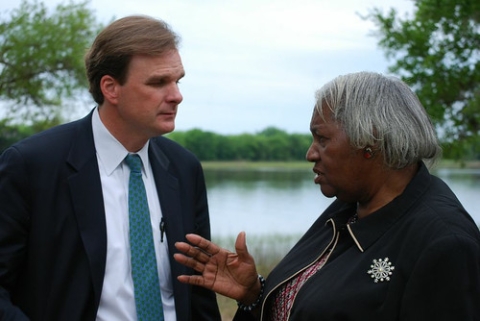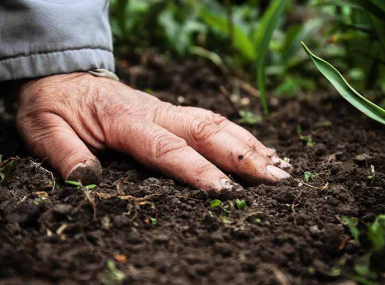USDA speakers present rural, agricultural programs and priorities

Key Takeaways
President Biden has made the fight against climate change a centerpiece of his administration and agriculture figures into being a major part of that priority. Robert Bonnie, deputy chief of staff for Policy and senior advisor on climate, told members of NACo’s Agriculture and Rural Affairs Steering Committee March 8 that some attitudes toward climate policy have shifted significantly since his first stint at USDA during the Obama administration.
“There was a lot of trepidation around climate policy, cap and trade policy, how it would impact agriculture and forestry in 2009 and 2010,” he said. “Today, there’s a lot more interest from some of the commodity groups, from folks in forestry, around climate change policy and the opportunities, incentives and markets to reward landowners and producers for ‘climate smart’ agriculture.”
He acknowledged there is remaining skepticism about environmental policy and ensured that it would work with agriculture and forestry practices.
“Anything we want to do at USDA, we want to look for ways that incentivize and markets and other positive approaches to climate change that can work in rural America,” he said. “That will be a critical tenant of everything we do.”
He touted soil health, cover crops, improved nutrient management and methane capture as climate policy practices that could align agriculture and forest management as a key for forestry.
Bonnie noted that his work is focused on five policy areas:
-
Enhancing USDA conservation incentive programs to partner with farmers, ranchers and foresters around climate smart practices
-
Finding ways for USDA to bolster private investment in climate smart agriculture and forestry and removing the risk involved in adopting those practices
-
Building tools for producers to better understand the implications of climate-smart practices and lowering the cost of participation
-
Improving the resilience of agriculture and forestry in the face of climate change
-
Ensuring climate-smart practices are available to farmers of all different sizes and cultural backgrounds
“Whatever we build has to work in rural, it has to work for agriculture and forestry,” he said.
More immediately, the Biden administration is targeting the COVID-19 pandemic and the resulting economic downturn.
Sara Bleich, senior advisor for COVID-19 at USDA, outlined the department’s role in the response with regard to food and nutrition, rural development, food programs and farm worker safety.
In responding to 30 million adults and 14 million children at risk of food insecurity, USDA has allowed state, tribes and territories to serve free meals to children, increased and expanded Supplemental Nutrition Assistance Program benefits, increased funding to food banks and expanded markets between agricultural producers and food banks.
The department has also increased EBT benefits, allowed states to expand SNAP benefits to the lowest-income households and revised the Thrifty Food Plan to reflect the cost of a healthy basic diet.
Bleich noted that with a death toll of more than 80,000, rural Americans are dying at a higher rate (in rural areas with fewer than 10,000 people) than in urban areas. That is likely a result of underlying health conditions, age, lack of health insurance and difficulty accessing medical care.
“This administration will prioritize economic development and growth in rural America by making it central to USDA’s mission,” she said. “To do that, we will harness the vast and powerful resources of USDA to target underserved communities and those who have been marginalized.”
The department will continue traditional USDA Rural Development programs, but also expand telehealth and distance learning resources, extend eviction and foreclosure moratoria for single-family borrowers and multi-family residents and distribute the $278 billion available through the Rural Development Business and Industry CARES Act program.
Bleich noted that many of the 45 percent of Americans who remain reluctant to seek out a COVID-19 vaccine live in rural areas, so she stressed the importance of county governments communicating the benefits of the vaccines to their residents, with whom they remain trusted messengers.

Attachments
Related News

Senators introduce bipartisan UPGRADE Act to support small and rural public water systems
On December 15, Sens. Lisa Blunt Rochester (D-Del.) and Roger Wicker (R-Miss.) introduced the Unincorporated Partnerships for Grant Resources, Assistance, and Drinking Water Enhancements (UPGRADE) Act (S. 3465), a bipartisan bill that would strengthen federal support for small public water systems and helps unincorporated communities access clean and affordable water.

House reintroduces bipartisan legislation to level playing field for rural communities
House reintroduced the Rural Partnership and Prosperity Act, bipartisan legislation intended to advance economic development in rural counties and overcome barriers to obtaining federal funding and resources.

U.S. Department of Agriculture unveils $700 million for regenerative agriculture
On December 10, U.S. Secretary of Agriculture Brooke Rollins announced the launch of a $700 million pilot program to support regenerative agriculture practices across the country.
